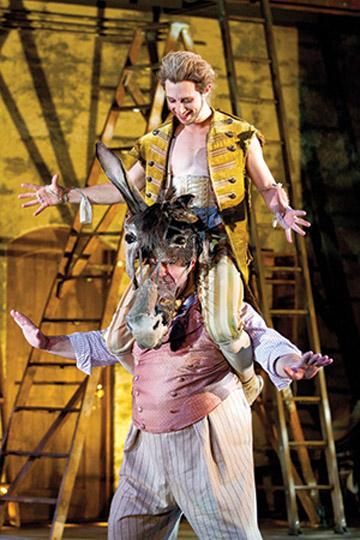Adam Green Takes Puck for A Spin in ‘Midsummer’
By • January 2, 2013 0 1684

This is another in a series of profiles and stories about actors who are performing iconic roles in and around Washington during Christmastime. In terms of Shakespeare, there are few characters more iconic than Puck, the henchperson to Oberon, king of the fairies, fly-by-night, magical creature, master of dreamscapes in “A Midsummer Night’s Dream,” now being performed at the Shakespeare Theater Company’s digs at Harman Hall and directed by Ethan McSweeny. We talked to actor Adam Green about Puck, the Shakespeare Theatre Company, working with Zelda Fichandler, being married to an actress, and a few other things in the Patron’s Lounge at Harman Hall recently.
As Kermit the Frog once noted, it’s not easy being green. And for actor Adam Green, it’s not easy being Puck.
He’s practically become the logo for the Shakespeare Theater production of “Midsummer.” His face is on the downtown Shakespeare banners. Like a beguiling master of the revels, he’s in TV commercials and the cover of the “Midsummer.” Hair slightly askew, surrounded by sparkling stars, lit by a bulb of moonlight, he’s Puck to the world.
Well met by moonlight, you’d spot Green as a Puck in a crowd, partly because Puck, who could be Robin, could be a spirit of the night, elfish, puckish, could be and always is an actor, the audience’s connection to the land of illusion. Mostly, Puck is an actor, more of this world than that of the world of the fairies.
In this production, the fairies and Puck often appear as if by magic, often bolted out of an area underneath the sea by jumping on a trampoline. Being everywhere and being able to circumvent the world in seconds takes it out of you.
“It’s very, very physical,” Green says. “It’s a wonderful part, but it’s really, really hard work. With a week’s work, counting the matinees, you can feel it.”
“I work out all the time a lot,” he says. “It helps, and you have got to do it,” he says.
Green walks in with back pack, street clothes, and while he isn’t back lit, you see the Puck in him right away. He’s slight, looks lots younger than he is (36-years-old) with a thin beard, trailing curiosity, as opposed to fairy dust.
“You try not to think about other people who’ve done the part,” Green says. “It’s iconic, but there’s lots of ways to do it. I saw that old Mickey Rooney movie from the 1930s. That’s really strange. Sure, there’s a lot of history in the part, in the play. It’s done so often. This is the play that young people, kids, even children, seem to love. You think of him as first, this Robin Goodfellow, who’s sent on this mission, which he messes up. Of course, given that he’s the king of mischief, that may be on purpose. He’s the chaotic element in the play. He goes back to the olden days. He can be Cupid; he can be Eros.
In this production, Green plays the parts of both Puck and Philostrate, the king’s butler. “He represents order and structure, he knows the rules, the exact words in the play the mechanicals do, he’s the exact opposite of Puck who is the prince of disorder.”
“I think audiences really get into this,” he says. “Some performances you can really feel it. They get what’s going on, the little jokes, the asides, the way it’s being done, and sure, a lot of it is about theater itself.”
You can say the same for Green. All actors set out to be a success but that means—everything from being a movie star which sometimes, but not often, rarely happens, to doing defining roles, to matching contemporary plays with classical theater—any number of things.
For Green, it’s the stage. It’s Shakespeare. It’s new plays which open up new challenges and old plays that open up new challenges.
A New Yorker through and through, he’s familiar to Washington audiences going back a little. Most recently, he managed to snag a Helen Hayes award nomination for supporting acting in David Ives’s version of “The Liar.” He was seen in “All’s Well That Ends Well” and “Two Gentleman of Verona,” all at the Shakespeare Theatre.
In New York, the plays get edgier and modern: “None of the Above” at Lion’s Theatre, “Bone Portraits” at Soho Rep; regionally in “Peter and the Starcatchers” at La Jolla Playhouse and “My Name Is Asher Lev” at Barrington Stage Company.
“I guess you could say I’m sort of a gun for hire,” Green says.
Theater is history—present and future. In 2005, Green had a part in Clifford Odets’s “Awake and Sing,” directed by Zelda Fichandler, the Arena Stage founder, and also featuring the late Robert Prosky. “That was quite an experience for me,” he says. “To work with Zelda and Prosky.”
By the way, a young actress named Miriam Silverman was also in it. Green and Silverman, who is also something of a fixture at the Shakespeare Theatre company, began dating and soon thereafter married in a ceremony at Circa 1799 Barn, a farmhouse and event venue in Ancramdale, New York.
Silverman, a luminous, gifted actress, is well remembered here for a finely crafted performance in the difficult role of Helena in “All’s Well That Ends Well,” managing the considerable accomplishment that the smart, gifted, funny and courageous heroine is in pursuit of a dolt.
“We were in that play together and in “The Liar”,” Green recalls. “Somehow, we weren’t on the stage at the same time. That’s a trick that Puck could have probably pulled off.”

